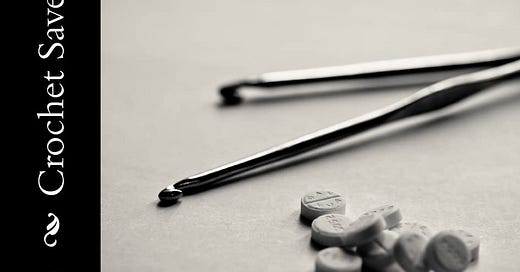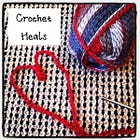How Sharing My Depression Story Helped Me Help Others
"I felt that it was important for me to share the stories of these other women who had entrusted me with them, and in doing so, I felt safer and more comfortable sharing my story."
In 2012, I published a book called Crochet Saved My Life, in which I shared the stories of two dozen women who had used yarn crafting to heal and improve the symptoms of a diverse array of mental and physical ailments. The first story shared was my own, a story of living through 15+ years of chronic depression without knowing or naming it, a story of nearing a depth of suicidality and pulling myself out of that depth with the aid of therapy, medication, yoga, a strong support network and, yes, crochet.
Sharing my story was relatively easy by the time that I published the book, but it had taken years and years and years to get to the point of saying, “I have depression. Here is my story.” I am so glad that I learned how to do this, because doing it not only allows me to own my authentic self but has also empowered me to help others in sharing their stories as a means to decrease the stigma associated with depression and other mental health issues.
I was in my late twenties when my world came crashing down around me and I finally accepted the label of “depression.” Depression for me was a near-lifelong thing that I had fought and fought, not willing to accept a stigmatizing label for what I was going through, certain that whatever I was experiencing was a basic character flaw that I could overcome with enough determination. I would cycle through periods of wellness, usually fueled by the positive energy of a new job or a new relationship or a new passion for something in life. The energy of those new things couldn’t sustain me forever and eventually I would plummet back into the feeling that nothing in life would ever feel good again.
Support this work so that it can continue.
Now that I know about depression from both a personal and professional perspective, I can easily see that this was what I suffered. But I didn’t know that at the time. I was oddly empathetic to others struggling with mental health issues while being certain that what I was going through was a lacking in character that required me to just buck up and move forward and take better care of myself. I didn’t actually know what taking care of myself meant, though I made valiant efforts at trying all of the things I thought might help.
I even tried therapy in younger years, but I was in such deep denial of my condition that the word “depression” never came up from either my mind or my therapist’s lips. I was angry and I was frustrated and I wanted to change my life, but things couldn’t change until I knew what was going on deep inside of me. I didn’t have a name for it and I needed to learn that name and accept it before I could move forward. The name came, as I said, in my late twenties when everything I had tried completely failed me and I found myself stuck in bed most days, barely moving through life.
I dragged myself back into therapy, lucking into a much better therapist this time, who also helped me find a decent psychiatrist. I was diagnosed with double depression – a case of immediate acute depression sitting atop a chronic, decades-old dysthymia (now called persistent depressive disorder). By this point I was just way too tired to deny anything. I accepted the label, I showed up for the therapy, I tried medication (which I’d always seen as a mistake in our over-medicated society) … and I began to get better. One day I found myself walking down a street and noticed that I was singing. I was shocked. I wasn’t unhappy. I might even be happy. Something had shifted.
So I started to share my story. I had started a now-defunct crochet blog, Crochet Concupiscence, and I mentioned a few times there how crochet had helped me through difficult times. Others responded that crochet had helped them as well, and I began to get curious about how it was helping others. I shared more of my story to encourage others to share their stories with me, first informally and then through interviews. That ultimately led me to write Crochet Saved My Life.
After years of denying the label of depression, it was easier for me to say it by this time. Having accepted the label had given me some relief, because there was a body of knowledge and ideas out there for healing from this condition. But I still had a lot of internalized stigma and shame that seeped through. The truth is that I would never have written just my story and put it out there. But as each woman shared her story with me, I was humbled and emboldened to make sure that I put this information out there for others to see. I was struck by how many different ailments we each go through and how crochet – or craft therapy – could help in such a variety of ways.
I felt that it was important for me to share the stories of these other women who had entrusted me with them, and in doing so, I felt safer and more comfortable sharing my story.
As the pages went to print, I still had a few lingering hesitations. It was fine to put my story out there for strangers to read, but friends and family members would also be reading this. I didn’t hesitate to share the story but I certainly felt defensive, afraid of what they would say upon realizing some of my deepest weaknesses. If it weren’t for the sharing of stories from others, I wouldn’t have been brave enough to share my own story. My story felt so small in comparison with the entire body of work that it was easier to put it out there.
And I am endlessly glad that I did. After the book was published, so many other people reached out to me to share their own stories of depression and suicide and self-harm and other forms of mental illness and how physical ailments had their mental counterparts. It wasn’t always easy being the recipient of these stories, opening up my email and reading heart-wrenching stories, but it was always amazing. I learned so much about the resilience of individuals, about the strength we each have to overcome whatever is difficult in our daily lives.
I went on to do extensive research into the health benefits of crafting, designing 100 exercises for crocheters to improve different areas of life, and then to launch an art project (Mandalas for Marinke) raising awareness about depression, suicide, and crafting to heal. Although all of this work includes fact-based research, the main thread running through everything is the sharing of individual stories, particularly those around coping with depression.
I am able to share my story freely these days, regularly letting people know that I live with recurring depression. What I have found is that my openness about this gives others around me permission to share their experiences, too. As more people share their stories through me, I am even more capable of sharing my story with others, which in turn allows even more people to open up. This, the story by story opening up of our truths, is how we end the stigma of mental illness.
If you read this far, perhaps you liked the work. The work does take work. It only continues with support, so please consider subscribing. My annual rate starts at $10 per year.









You know, sharing your story today is a gift to the whole world. Do you ever wonder how many lives you have saved with your books, blogs, socials....? I am certainly one. Hugs!
Tom retired from diving but came back because his son, Robbie, told him that he wanted to see his Dad diving. I have verified that it is knitting.